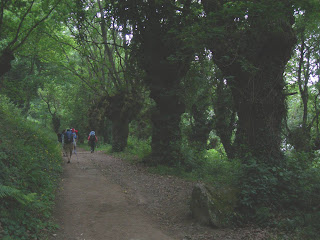 Mike
MikeVictoria
Liz M
Connor
 Sasha
SashaMarianne
Richard
Liz K
 Connie
ConnieAnna
John
Jim
 Jackie
JackiePaul
Beth
Tom
Between May 28 and June 10, 2007, a group of Fordham students and faculty walked the Camino de Santiago in northwestern Spain from León to Santiago de Compostela, about 200 miles.
In the middle ages, the Camino was a pilgrimage to the relics of St. James, and a major destination for medieval travelers. The revived camino is a modern phenomenon, with thousands of peregrinos/peregrinas walking, cycling, traveling to Santiago each year, or doing sections of the various trails that lead there.
As was the case with medieval pilgrims, modern pilgrims walk for many reasons, find many things along the way, and tell many stories about what has happened to them, although they all share in the shifting community of the road. This blog is a short record of the experiences of the Fordham group, and some of what struck us at various points along the route.
--Richard





















